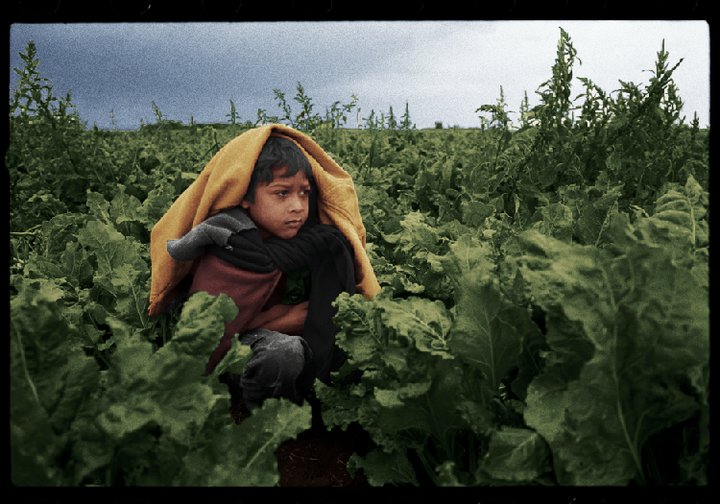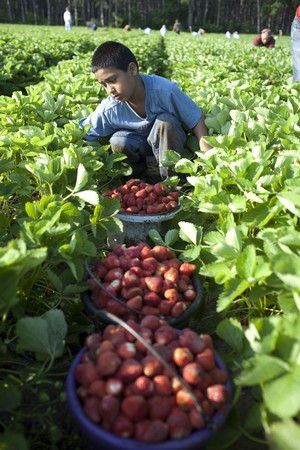Today, we’re playing a game. Read the clues and try to figure out the location before you get to the end of this post.
- In this country, children between the ages of 12 and 18 are legally allowed to work long hours in all sorts of hazardous conditions as long as the job is classified as agricultural work. If the farm is classified as a ‘small’ farm, children of any age can work as hired labourers.

- Some of the most common jobs include:
- picking fruits and vegetables
- picking tobacco
- hoeing cotton and weeding cotton fields
- Some common job-related hazards include:
- using sharp farm implements such as knives and chainsaws
- operating heavy machinery such as tractors and grinders
- pesticide exposure
- sexual harassment and violence
- exposure to extreme temperatures
- repetitive motion injuries
- unsanitary conditions
- extremely long workhours sometimes without a day off during peak seasons
- This country’s Department of Labour estimated that 3% of agricultural workers are children however, this is a flawed measure since it does not include children below the age of 14. Other estimates are as high as 9% of agricultural workers, however, this also does not include undocumented or subcontracted workers and workers working on their own family farms. Farms in this country rely on subcontractors to provide an estimated 15% or more of their workers. These labour contractors mediate the relationship between the growers and the workers. Therefore, the growers often have no contact with their subcontracted labourers. The growers pay a lump sum to the labour contractors who often manage all issues related to wages, transportation to job sites, and pay deductions.

- Up to 40% of farm labourers are migrants that move with the seasons. Farm labourers are also ‘overwhelmingly poor’. These patterns of migration and poverty drive many adult labourers to ask their children to work alongside them. The impact on the child’s education can be significant. In some cases, because of the migration with the seasons, children may leave school in early spring and return in the late fall missing a few months each year. One third of child farm labourers drop out of school altogether.
- Both adult and child farm workers are often not paid the minimum wage. In some cases, children are paid less than their adult counterparts, in other cases, a legal loophole provides exception for small farms and farms paying a piece-rate [which encourages unsafe work practices since safety equipment often hampers work speed]. Furthermore, overtime pay is not required for agricultural workers.
- This country is not mentioned in the US DoL’s List of Goods Produced by Child Labor or Forced Labor despite the fact that the legal loopholes for farm work create, reinforce and support conditions which are in clear violation of the ILO’s convention for the prohibition and elimination of the worst forms of child labor (no. 182 adopted in 1999). ‘Child’ in this convention is defined as all persons under the age of 18 and the worst forms of child labour includes “work which, by its nature or the circumstances in which it is carried out, is likely to harm the health, safety, or morals of children (Article 3(d))”. This country was one of the first to ratify this convention and has been very active in promoting and instituting the convention worldwide.
- Did I mention that this country is one of the top producers of cotton this year? Most of its cotton is exported to major clothing producers including China [the top destination], Turkey, Mexico, Indonesia, Thailand and Vietnam.
The Harvest/La Cosecha – Promotional Trailer from Shine Global on Vimeo.
Shocked? So was I!
For more info, check out the following:
Human Rights Watch: Fields of Peril
- A lot of the information in this post is summarized from this report. Thanks to Human Rights Watch for their continuous and unwavering commitment to this issue. This report contains a lot more information that I barely touched upon with enormous detail on the plight of these child farm workers. They also have first hand accounts of the working conditions the children must endure. This report is a must-read if you are interested in learning more about this issue.
Cynthia Castaldo-Walsh’s post on NotGoodEnough.com
- This is an excellent overview of the legal loopholes in the Fair Labor Standards Act (1938) which allow for these conditions. She also gives a brief description of changes proposed in the Children’s Act for Responsible Employment. This bill was introduced in 2009 and is still being churned through government machinery. You can track what’s happening with the bill here and here.
Mike Elk’s post on In These Times
- This post discusses the proposed revisions to federal law by the Department of Labor to better protect child farm workers. In particular, Elk points out how slow the process has been but he does also draw attention to the next resource in the list.
- The DoL’s proposed changes to federal law are up for public comment until November 1st and can be found here.
The Association of Farmworker Opportunity Programs Children in the Fields Campaign
The Harvest/La Cosecha: The Story of the Children Who Feed America
Special thanks to Grist.org for bringing this issue to our attention. It really made us think about our preconceptions. Sometimes, just because something is “American [or Canadian] made” doesn’t necessarily mean it is responsibly made. Growers may be fulfilling their legal obligations, which is part of their responsibility, yet they are under enormous pressure to provide products at low prices giving them incentive to maintain and perpetuate this system of labour. At the same time, we, as consumers, are also part of the problem by constantly demanding low-priced commodities. But, these low prices do not reflect the real costs of production. These issues are very complicated. There is no easy answer. At the end of it all, someone, somewhere along the line still has to pay the real cost in one way or another.






Pingback: Happy New Year! | Social Alterations